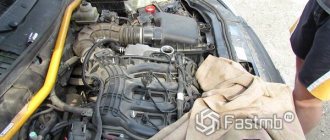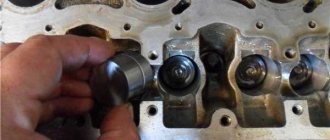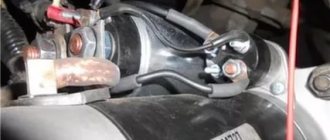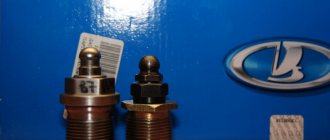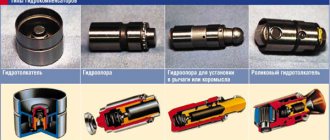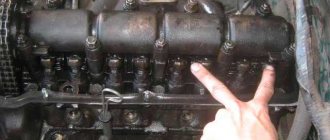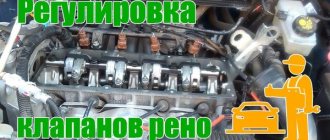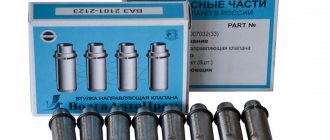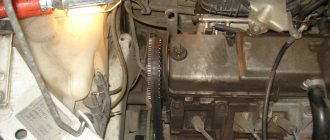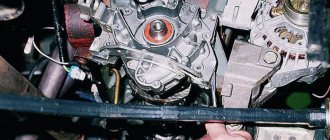January 07, 2021 Lada.Online 164 423 27
Have you encountered any unusual engine noise? Perhaps it's the hydraulic compensators knocking. This problem occurs most often on Priora, but knocking also appears on other Lada cars (for example, Granta, Kalina, Largus Niva 4x4, Vesta or XRAY). Let's figure out why such a knock appears in the engine and how to deal with it.
The hydraulic compensator (also known as hydraulic pusher) is a cylindrical shape that is located between the camshaft and the valves. They perform two functions: transmitting force from the camshaft to the valves and eliminating gaps in their drive.
Diagram of operation of the hydraulic pusher in the valve mechanism of the VAZ-21126 engine: 1 – valve; 2 – check valve spring; 3 – check valve; 4 – cylinder head; 5 – camshaft cam; 6 – pusher; 7 – plunger; 8 – plunger spring; 9 – sleeve; 10 – check valve body; A, B – hydraulic pusher cavities; B – oil channel.
Hydraulic compensators are knocking: establishing the reasons
So. Car enthusiasts with extensive experience claim that there will be no knocking on a fully operational car. And if extraneous noise appears, it means something is wrong. Why can these nodes knock?
Among the main reasons are mechanical wear or wear that forms on the surface of the plunger pair. Also, extraneous sounds may occur due to unstable operation of the valve responsible for the oil supply.
The compensators do not knock all at once. Sounds can appear due to wear or failure of even just one part.
Which hydraulic valve compensators are better to buy?
To buy the necessary compensator in the store you need.
1. When purchasing, provide the seller with the VIN code of the car. This will give him the opportunity to select the desired product in the catalog.
2. Know the characteristics of the hydraulic compensator: height, outer diameter, as well as the type of product being installed.
3. Pay attention to the type of product and packaging materials. The part must be well processed, free of burrs, the box must be equipped with information about the release date and manufacturer.
4. When choosing, you should give preference to products from well-known companies on the market. A cheap product is attractive due to its price, but its quality will make you regret your purchase.
In order not to run into a fake, the hydraulic compensator should be purchased in large stores that value their reputation.
Compensator valve
It happens that this very valve does not hold oil. Then, when the engine is cold, it may leak due to loose connections. This is how air enters the system. When warmed up, it disappears ten minutes after starting.
To diagnose this, you need to start the engine. Let the engine run for at least three minutes. You need to keep the speed at 2500. Then reduce it to idle speed, and then add speed again. This is enough for the air to completely escape and the compensator to stop knocking. But every time you start, the hydraulic compensators knock again and again when cold.
Basics of the design and operation of a hydraulic compensator
Configuration
The idea of automatic regulation of thermal clearances can be implemented in two versions: a conventional hydraulic pusher and a hydraulic support. The latter is used in gas distribution modules with rocker arms. On the Lada Priora in the sixteen-valve version, the intake and exhaust are equipped with individual camshafts. The optimal solution for this arrangement is the use of a hydraulic pusher.
The Priorov hydraulic compensator on the 126 engine consists of the following parts:
- A plunger pair, including a cylindrical cage and a piston with a ball valve.
- The outer housing is a pusher.
- System of grooves and holes for oil supply.
Principle of operation
The oil composition enters the internal cavity of the piston and, overcoming the resistance of the spring, pushes the ball away to fill the closed cylinder. When filling the liner, oil pushes the piston out and the hydraulic tappet rests against the cam. Next, the ball valve is locked and the assembly unit works like a regular pusher on motors with an adjustable valve mechanism.
Inlet
It happens that this hole can become clogged, but it is intended for lubricant. How does the compensator continue to work as the engine warms up? The lubricant heats up, then the gap expands. The debris that covered the holes disappears, and oil begins to flow in quantities close to normal. However, when cooling, various viscous particles will clog the hole again, which will lead to poor lubricant access. This is why hydraulic compensators knock when cold.
To fix the problem, you can try changing the oil.
How the system works
Hydraulic compensators are an integral attribute for many modern car models. Previously, valve stroke had to be adjusted manually, which was done on AvtoVAZ engines in earlier cars.
The hydraulic compensator is designed quite simply. It looks like a cylinder, inside of which a plunger is installed. Let's consider the principle of its operation step by step.
- When starting the engine, the device is affected by the camshaft cam.
- Under the action of the cam, the compensator moves lower, after which its plunger exerts pressure on the valve.
- Under the influence of pressure, the valve opens, but strictly to a certain height.
The operation of the devices is adjusted using ordinary oil. It enters the space located under the plunger, and the greater its pressure, the greater the load on the plunger itself.
Oil filter
If it is clogged, then this is one of the reasons why the hydraulic compensators knock when cold. Extraneous sounds stop as the engine warms up. Then some of the lubricating fluid passes through the filter. However, in most cases, a miracle does not happen. The driver will hear a knock even when the engine is hot.
To get rid of this problem, you just need to replace the filter.
More experienced car enthusiasts constantly keep a “logbook”, where they write down the mileage when changing the oil, as well as the operation time. This helps a lot to complete it on time.
There are three main signs that the hydraulic lifters are malfunctioning
- when the engine is running, we can hear an extraneous high-frequency knock;
- the engine loses power, especially when the gas pedal is depressed and its speed is high;
- engine operation is uneven, characteristic jerks appear;
- the sensor often indicates that the oil pressure has lost;
Replacing the timing belt Lada Granta 1.6 with 16 valves
If you have repeatedly noticed such signs in your engine, prepare for the fact that the problem components need replacement. However, before doing this, try changing the oil - sometimes this saves the situation. If the oil has already exhausted its service life or you filled it with low-quality oil from the very beginning, this may be the reason for the incorrect operation of the hydraulic compensators. Just remember that the old oil needs to be drained after the car has been standing for a couple of days so that it comes out of the hydraulics. The engine should be washed with special products or ordinary kerosene.
If this does not help, the set of hydraulic compensators must be changed. How much does this procedure cost at a car service? Quite a lot, although there is nothing complicated about it. You can easily do it yourself, you just need to follow the sequence of actions (the description of the replacement process was made for the Lada Priora engine with 16 valves):
- Disconnect both terminals from the battery.
- It is necessary to remove everything that prevents access to the intake manifold. These are, first of all, the wires going to the injectors, the air filter and the cable leading to the gas pedal.
- On a car like the Lada Priora, the intake manifold mounting bolt is obscured by the generator. You need to remove the belt from the generator, loosen the bolt that secures it, and then move it to the side.
- Next you need to remove the ramp and injectors. If the car is equipped with air conditioning, you will also have to remove the circulation pipes, otherwise they will prevent you from getting to the manifold.
- Unscrew the remaining intake manifold mounting bolts and remove it.
- The next step is to remove the valve covers, timing belts and two camshafts.
- Now you have access to the hydraulic compensators. Do not rush to dismantle them right away - first check whether replacement is needed. This can be done this way: press your finger on the cylinder - if you feel resistance, then the hydraulic compensator is still ready to serve, but if it immediately falls in - change it without hesitation. There are no protrusions on the cylinders, so it is most convenient to remove them using a small but powerful magnet.
- Advice: at the same time, inspect the camshaft seals; they may also need to be replaced.
- When reassembling in reverse order, do not forget to also remove the remaining old sealant on the valve covers and apply new one in its place. It is sold in auto supply stores and is usually red in color.
If you followed the reverse order correctly when reassembling, then everything should be fine. After replacement, start the engine and let it idle so that the oil enters the hydraulic compensator plungers. Then increase the speed by pressing the gas pedal - this will speed up the grinding process. If you have done everything you need to do, the knocking in the engine will go away and it will run smoothly, without jerking.
Why do hydraulic compensators knock when cold: Priora
This is a common problem on these models, as well as on many others from AvtoVAZ. Let's try to figure out where the knocking comes from and how to deal with the problem.
Here are some typical causes of knocking noises. So, if there is a knocking sound during a snack, and then the noise disappears, then this cannot be considered a problem. If extraneous sounds appear both on a cold and sufficiently warm unit when the speed increases, then most likely the unit will have to be replaced. Possible contamination - here you can get by with simple cleaning.
knocking Elimination without replacing hydraulic compensators
Replacing knock sensor Priora 16 valves
But despite the simplicity of the entire design, Priora sometimes encounters problems with the gas distribution mechanism. Over time, during the operation of the vehicle, a malfunction such as hydraulic compensators knocking appears. In addition to the fact that they cause unpleasant knocking sensations, they also have an impact on the performance of the engine in the Priora, as a result of which its power decreases.
The reason for this was that the knocking of the hydraulic compensators could be due to the motor oil poured into the engine. The fact is that the hydraulic compensator is very sensitive to quality. And the oil does not correspond to the markings recommended by the manufacturer, this will inevitably lead to it starting to knock.
Often the problem of hydraulics knocking can be solved by simply changing the oil. To do this, after draining the used oil, the engine must be washed with a flushing fluid and filled with fresh fluid..
It is important to take into account that after changing the oil, the car should be allowed to run at elevated speeds for 5-7 minutes. Moreover, immediately after starting the engine, it will be clearly audible, knocking like hydraulic compensators, since fresh oil has not yet reached the sub-plunger space
But as oil circulation increases, the knocking noise will gradually subside and over time should completely disappear.
The first method to use is flushing liquid, which is poured into Eta. The oil liquid is cleaned during engine operation. The disadvantage of this option is the possibility of purchasing low-quality flushing liquid, which will not bring a positive result. Another manual method is washing. To do this, the hydraulic heads are removed from the head and thoroughly washed in kerosene.
When performing this operation, it is important not to confuse the parts; each hydraulic compensator must be installed strictly on its own volume. The place to remove them from the engine will be discussed below.
Hydraulic compensators and “Accent”
The reasons for the knocking are standard here. The owners write that the problem can be solved by changing the oil. More experienced owners believe that if hydraulic compensators knock when cold (Accent is no exception), this is nothing more than a feature of the engines.
But in general, most drivers change oil with a viscosity of up to 5W30, and this allows you to completely get rid of the knocking of these mechanisms in the engine.
The oil pump should be checked. It may not be producing the required pressure. Many also recommend lubricant products from.
How to eliminate the knocking of hydraulic pushers on Lada Priora
Timely and high-quality maintenance of the engine oil system is the key to flawless operation of the hydraulic compensator mechanism. After all, the unit is designed for use throughout the entire resource of the power plant.
Use of recommended lubricant
When the hydraulic pushers just start knocking, the manufacturer recommends changing the lubricant to a proven option. Therefore, when the question arises of what kind of oil to pour in principle, it is worth analyzing reviews to determine the acceptability of a certain model of oil product for hydraulic compensators.
Of course, the best choice for Lada Priora will be the composition recommended by the manufacturer, specified in the instruction manual. However, not all current popular products are included in the list.
An analysis of opinions shows that, indeed, with the universal viscosity of 10W-40 or 5W-40 specified by the factory, not every oil is suitable. For example, Shell Helix Ultra 5W-40 causes knocking already at 15,000 km, while on Liqui Moly Optimal Synth 5W-40 the hydraulics are silent even at 80,000 km.
Reviews show that it is optimal to choose the following lubricants:
- Total Quartz 9000 Energy 5W-40.
- Mobil Ultra 10W-40.
- Wagner Windigo 10W-40.
Flushing
Many owners, in advanced cases, resort to general engine flushing. However, the effectiveness of such an event in the fight against knocking GCs is low. This is explained by poor oil pumpability in the area of the hydraulic pusher chambers. If changing the lubricant does not help, the best solution is to remove the cylinder head cover and find which hydraulic compensators on the Lada Priora 16-valve engine are knocking and determine the reason for this. Defective parts are identified by diagnosing running resistance with a wooden wedge. A fast movement speed in comparison with other hydraulic supports indicates wear of the hydraulic module, the presence of a constant gap indicates its coking.
Attention! The wooden wedge must be pressed against the non-working surface of the cams.
Effective removal of carbon deposits inside the cylinders is their local washing. Worn assembly modules cannot be repaired.
Additives
Additive compounds help delay identifying the causes and cleaning the timing belt. There are several products available in the market. The most popular products are from Liqui Moly and XADO. The effectiveness of substances depends on the specific case. Fans of motor additives often equate this class of chemistry with a waste of money.
How to check hydraulic compensators yourself
You can check the condition of the spring.
You can also measure the size of the gaps between the guide bushing and the valve stem. If the gap is large, it must be eliminated.
Then you should turn the crankshaft so that the knocking valve begins to open. After this, you can turn the spring. The valve will turn with it. After starting the engine, the knocking noise should disappear completely. If the hydraulic compensators are still knocking when cold, the Priora needs to repeat the above operations. It is best to replace the damaged unit with a new one.
Increased and decreased clearance consequences
Insufficient intake valve clearance (valves are clamped) does not allow complete closure. Tightened intake valves in a gasoline engine will cause the air-fuel mixture to partially burn in the intake. In this case, starting the engine is complicated, the unit does not develop power, consumes a lot of fuel, etc.
For exhaust valves, the consequences of improper adjustment are much more serious. Hot gases from the combustion chamber will rush through leaks, causing the valve disc to burn out and destroy the valve seat. Insufficient valve fit in a diesel engine can lead to a significant drop in compression, which will not allow the diesel engine to continue to operate normally.
A large gap causes strong shock loads, as a result of which a sharp and frequent metallic knock will be heard in the valve cover area, which increases with increasing speed. In this case, wear of the valve mechanism, camshaft and other timing elements accelerates. If the valves do not open completely, then the flow area is reduced. This means that the cylinders are less well filled with the fuel mixture (air in a diesel engine) and are poorly ventilated. At the same time, engine power is greatly reduced, and the content of harmful substances in the exhaust gases increases.
It is quite obvious that not only the most important performance indicators of the power unit, but also its overall engine life will depend on correctly adjusted valves. Manual adjustment of the thermal clearance of valves is a planned procedure, is carried out using a feeler gauge, shims and levers, and also requires certain skills. This adjustment is carried out every 10-15 thousand kilometers. An additional complication of manual adjustment is that in order to achieve “soft” operation of the timing valve, it is necessary to adjust it taking into account various temperature fluctuations, and not according to the average value. Many car repair shops don't do this.
Taking into account these difficulties, so-called hydraulic compensators began to be used in the timing belt design, which automatically select the required gap.
Thanks to this solution, the need to manually adjust the valves is completely eliminated. Hydraulic valve thermal clearance compensators are a timing part that is capable of independently changing its length by an amount equal to the thermal clearance.
How to find out which hydraulic compensator has failed
Acoustic diagnostics are usually sufficient. If this method does not help, then press the knot with a screwdriver. A normally functioning structure will compress if sufficient force is applied. If it is easily pressed through, then it is faulty and should be replaced as soon as possible.
In the second method, you should install the cams of the camshaft mechanism one by one with their protrusions facing upward. Here you need to make sure that there is a certain gap between the cam and the pusher. When pushing the compensator down, try to compare it with known-good parts. If there is a gap or the lowering speed is high, then you need to clean or replace the element.
Main types of faults
We answer the question of how to check hydraulic compensators for functionality. It can be noted that there are four reasons for the occurrence of malfunctions:
- Increasing the size of the gaps in the areas indicated by the arrows in the photo below. Gaps are formed between the plunger and the plunger bushing. The result will be increased oil leakage. The compensator simply will not have time to “select” the thermal gap;
- In rare cases, the check valve does not close tightly. Which, at a minimum, makes it impossible to create sufficient pressure generated between the sleeve and the plunger;
- The bushing should move freely relative to the plunger. In the areas indicated in photo 3, a blockage may appear, and then the plunger pair jams;
- Clogged engine oil passages are another reason why compensators stop working.
Points 1-3 are illustrated in the photo:
Knocking after replacement
Usually new parts don't knock.
If you still hear sounds, then this is a manufacturing defect or a problem with the valves. In order to perform an accurate diagnosis and make sure that there is nothing wrong with the valves, it is necessary to check their fastenings. There is a possibility that the parts did not shrink as required. We simply tighten them and thereby remove the knock of the hydraulic compensator.
Noises when hot
Hot tapping is more systematic. It is observed even when the engine is already warmed up. The reason for the occurrence of such periodic sounds is the increased gap between the hydraulic compensator sleeve and the plunger. It occurs for the following reasons:
- wear of the hydraulic pusher parts or “sticking” of the valve through which the lubricating fluid passes;
- the use of low-quality motor oil or the wrong choice of its viscosity;
- blockage of oil channels;
- oil filter contamination;
- high air content in the engine oil and, as a result, in the hydraulic pushers themselves;
- flaring of the hydraulic pusher seating area, which expands even more when heated.
